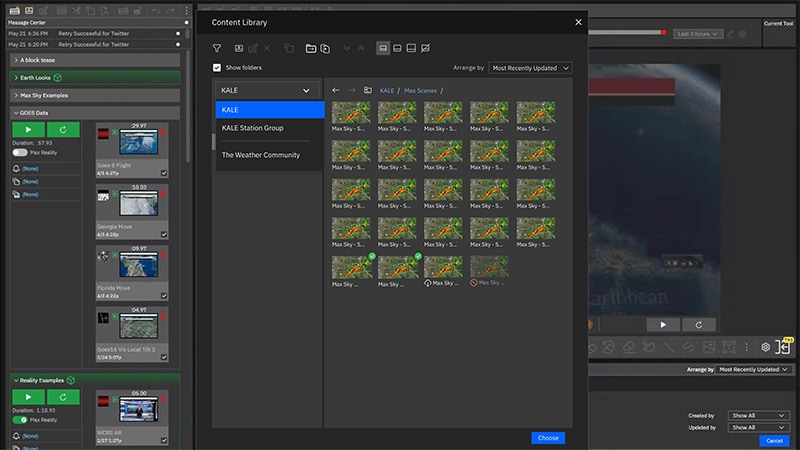
Cloud brings new possibilities to weather storytelling, workflows and TV operations

TV stations have significantly expanded their commitment to local news in recent years, and not just on linear platforms. To keep up with demand for fresh content, they have relied increasingly on news sharing and collaboration, making it easier for newsrooms to share their best work – or local stories that have become national news – with other stations in their group.
What if they could do the same for weather, the No. 1 reason viewers tune in to local news?
A meteorologist in Florida could share a well-thought-out explainer video about an impending hurricane with colleagues across the U.S. Or meteorologists in distant cities could step in and back up a colleague who’s spending hours on the air during a multi-day severe weather event. They could even broadcast from afar for a colleague who has been cut off completely from local weather data.
“Audiences gravitate to television during weather hardships,” said Jerry Martz, senior account manager at The Weather Company, during the TVNewsCheck webinar, “Optimizing Weather Storytelling and Workflows in the Cloud.”
“Stations that want to enhance their coverage in order to hang onto those new viewers can benefit from cloud workflows, which support the ability to create more content for multiple platforms quickly, easily and efficiently and also share their content “faster with far less friction” than they can today,” Martz said.
The company’s new Max Cloud platform, currently in field trial, paves the way for this while also providing the redundancy and remote workflows necessary to a company’s disaster recovery plan.
A hybrid cloud approach phases in new workflows
The Weather Company’s journey to the cloud will take place in phases, starting with a hybrid approach that allows stations to gain access to some cloud workflows while gradually transitioning more to the cloud as they phase out old equipment currently on premise.

The Max Cloud user interface allows drag and drop sharing among stations
The opening phase of the journey will provide a locker in the cloud which stations in a region or an entire group can use to share content.
Stations in Texas that generated Winter Storm Uri graphics could share those graphics “cloud to ground” with sister stations using the drag-and-drop sharing and distribution capability of Max Cloud without the user having to leave the Max application, Martz said.
The locker would also enable meteorologists across a group to collaborate via new workflows and “in ways they might not have thought of before,” Martz said, and would allow each station as well as the overall group to become more efficient at delivering weather and traffic.
Another major benefit of moving to the cloud, Martz said, is that it gives stations the ability to support and back one another up. In an all-hands-on-deck situation with wall-to-wall weather coverage, he said, meteorologists in non-affected areas can help out by ramping up and creating digital content for the meteorologist covering the weather event so that it is available at a moment’s notice.
Finally, working in the cloud puts a station on better footing in the case of disaster.
Martz said data isn’t lost in the case of fire or flood if the station has weather operations and workflows in the cloud.
New possibilities for sharing, collaboration
Lockers in Max Cloud allow the sharing and collaboration between stations, said Bob Millis, offering manager for Max Cloud at The Weather Company, and only those authenticated as having permission to access the content will be able to do so.
“Not everyone has access to go tiptoeing through your locker. It’s by invitation only,” Millis said.
If a station went down or was in trouble, Martz said, “another station would be able to step in and broadcast as if they were you, with your look. It opens up possibilities for the way a station could collaborate for digital or broadcast.”
Currently, Millis said, some clients are participating in a field trial with Max Cloud, and the company is open to bringing in other field trial partners with hardware capable of running Max v7.3 software.
“We are early enough in the process that we want some real-time feedback,” Martz said.
The current iteration of Max Cloud makes it possible for stations to share content and cover each other, while updates coming out later this year will support regional work groups and offer even greater disaster recovery.
And just as Max Cloud is rolling out in phases, so is the expectation that broadcasters will initially use a cloud-first hybrid deployment before replacing complete physical Max workstations, Millis said.
Gradual reduction of on-prem equipment
Max historically has required two Max core servers, two or more Max workstations to handle the real-time rendering and video output, and a single appliance for publishing digital content. Migrating to the cloud, Millis said, means a smaller connected set of appliances, which reduces capex as those appliances age out. Once weather data processing is completely in the cloud later this year, stations can begin to retire their core servers, Millis added.

Cloud workflows allow stations to reduce hardware footprints over time
Millis acknowledged that some broadcasters may be concerned about accessing content in the cloud rather than having it locally. At first, they will still have local cores that can cache content locally, he said.
“Over time, we will all gain confidence” in the cloud, he said, and stations can choose to “reflect everything in your cloud locker versus local storage.”
Millis said Max Cloud is available via a SAAS model and that cloud-based rendering may eventually be priced on consumption.
Max Cloud is on the IBM Cloud, although Millis said multi-cloud may be a strategy for the future as its capabilities evolve.
The company also doesn’t want to rush certain aspects of production like playout to the cloud, for instance, he said, because there are so many layers.
“We want to do it right,” Millis said. “It’s not a lift and shift to the cloud, but a reimagining.”
Overall, Martz said, adopting Max Cloud for weather operations and workflows can drive efficiency and lead to different ways for stations and teams to work together, Martz said, adding, “The entire station can benefit from the shift.”
“A chief engineer will have less hardware to maintain, secure and operate,” Martz said. “A general manager will see overall cost savings due to a smaller hardware footprint and less freelance work. Meteorologists can collaborate with their peers from sister stations to develop the most engaging content, which can be tailored to each market. News directors can be rest assured that they’ve added new flexibility in their weather coverage, plus additional layers of redundancy.”
For more information about Max Cloud, or to see a demo, please contact Jerry Martz.
Watch a video of the webinar here.























Comments (0)